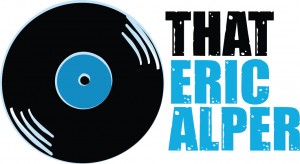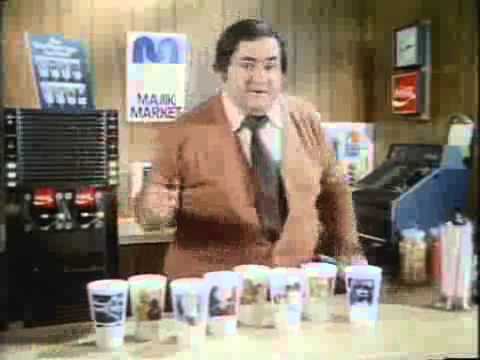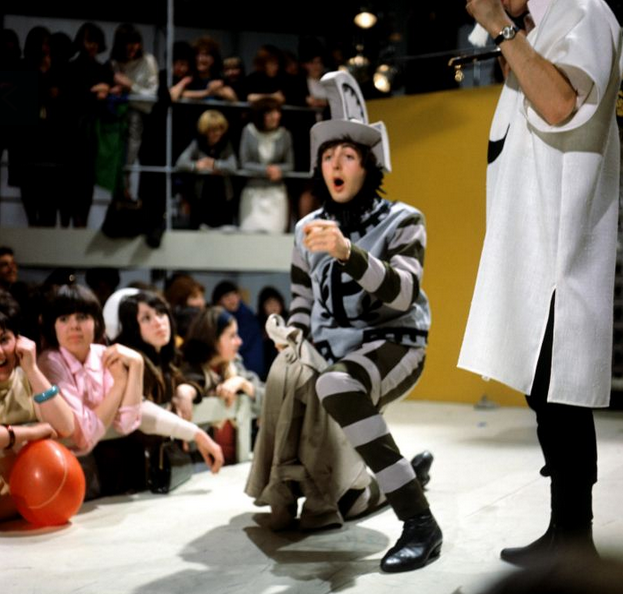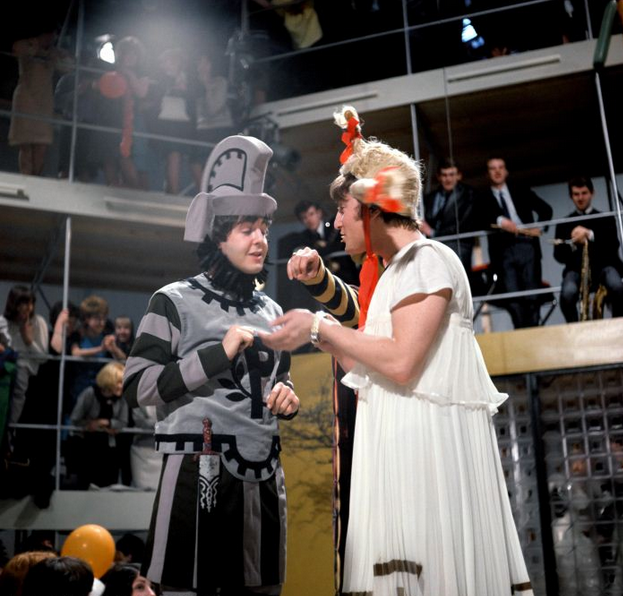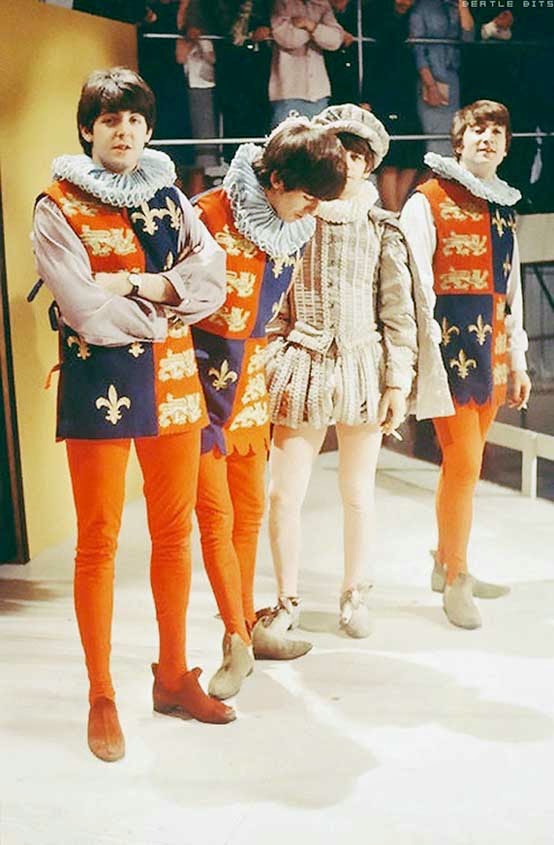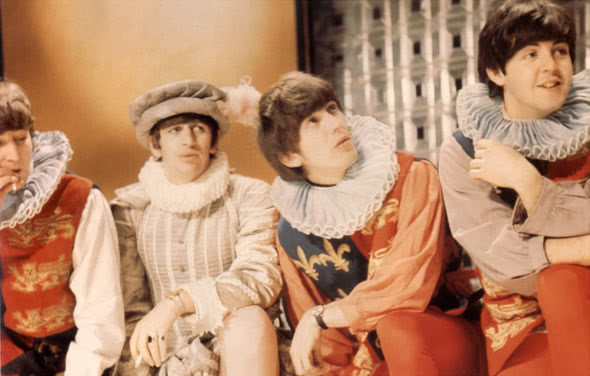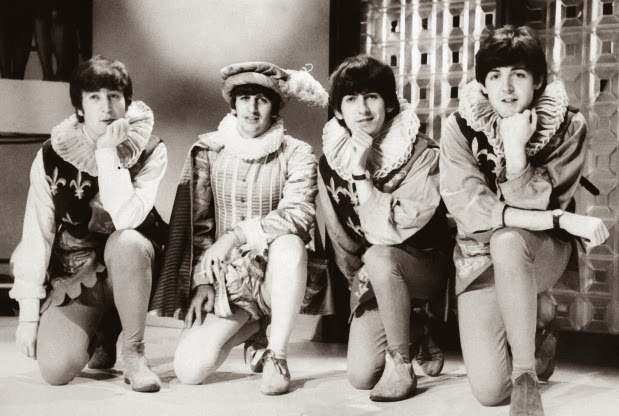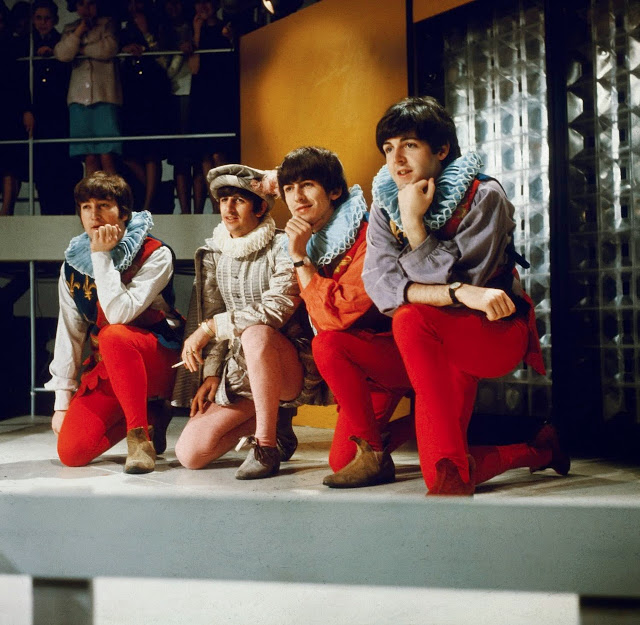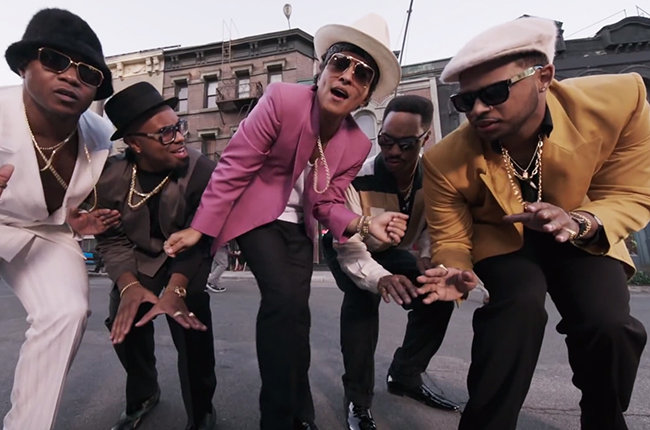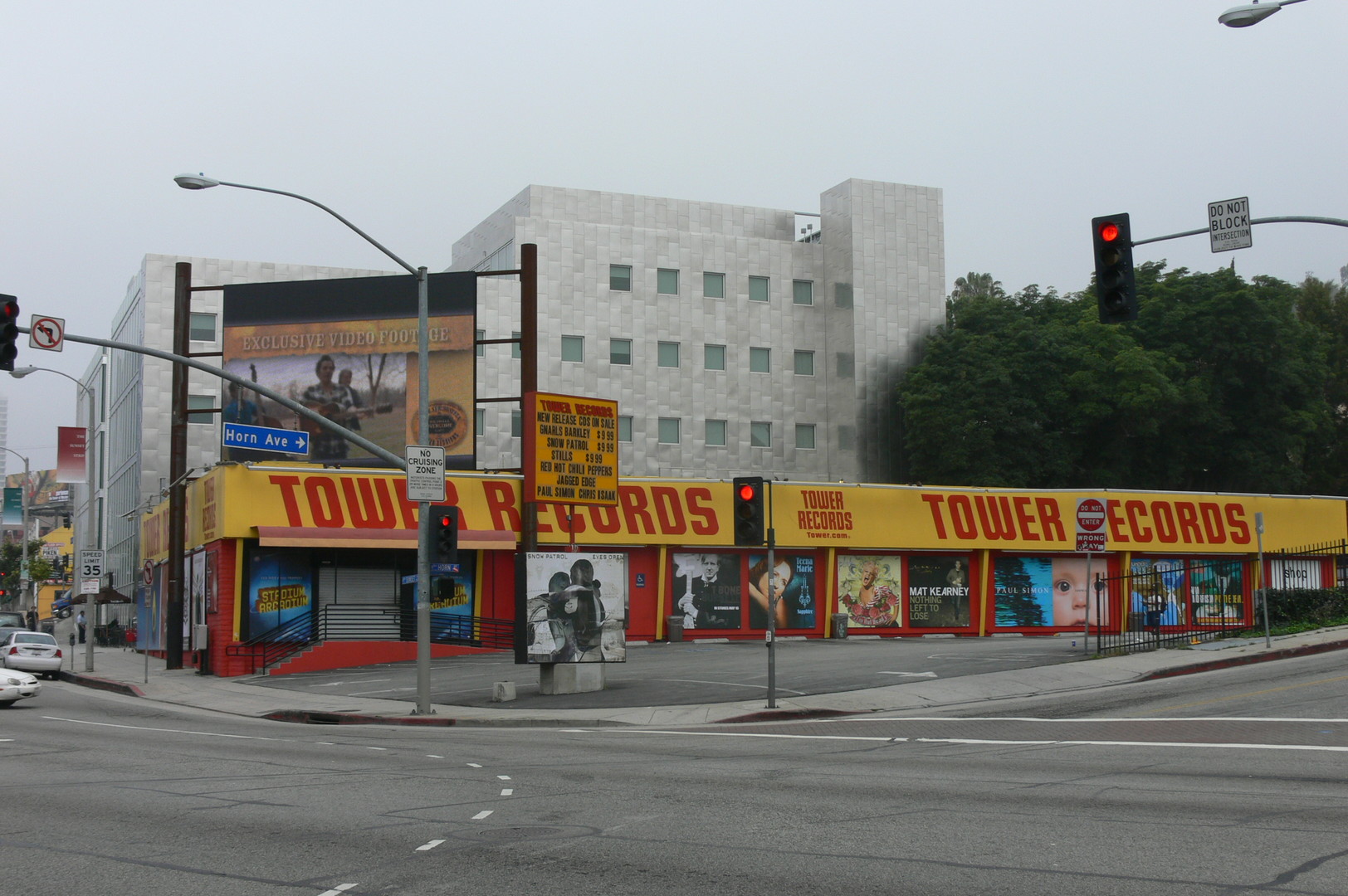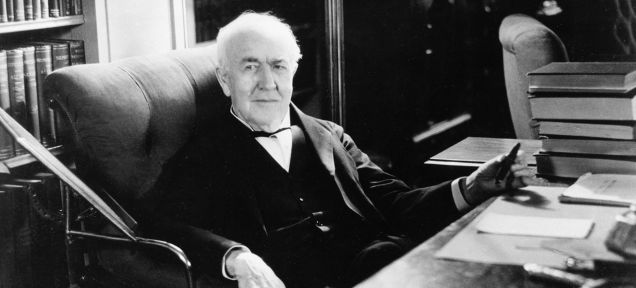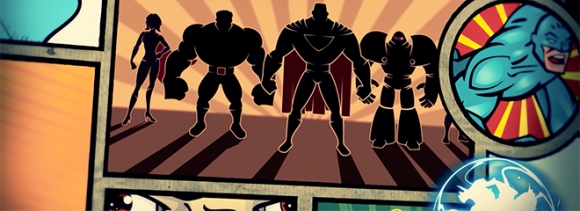Filmed on October 18, 1977, this ad for the first series of Star Wars plastic cups from a convenience store chain called Majik Market is among the earliest promotional tie-ins to be televised following Star Wars’ release in May.
Walter the golden retriever is VERY confused by his toy
Walter the golden retriever answers the age-old question – are dogs really impressed with the squeaky sound coming from their toy? Kinda. Trouble is, Walter is a bit confused as to where it’s coming from.
That Time The Beatles Performed Shakespeare, 1964
In April of 1964, just a month after their famous debut on the Ed Sullivan show, The Beatles followed it up with a sketch from Shakespeare’s A Midsummer Nights Dream as part of a one-hour Beatles television special. Britain, at the time, was celebrating the poet’s 400th birthday. One of the strangest performances the group ever made, that’s for sure.
The 2015 Nimbus Mix Contest Offers $100k in Scholarships to be Awarded
Do you aspire to a career in the modern music industry? Whether you are in high school or already graduated the 2015 Nimbus Mix Contest is for you!
Nimbus Studios in Vancouver are excited to announce the 2015 Nimbus Mix Contest will feature two simultaneous competitions: one for high school students (13-19) and one for adults (high school graduate or 19+) with up to $100,000 in scholarship prizes to be awarded!
Here’s the 2015 prize breakdown:
In High School?
1st Prize: $25,000
2nd Prize: $10,000
3rd Prize: $5,000
People’s Choice: $10,000
Already Graduated or Over 19?
1st Prize: $25,000
2nd Prize: $10,000
3rd Prize: $5,000
People’s Choice: $10,000
Stems will be available to download on April 1st. You will have one month to mix your track. Submissions will close on May 1st and the winners will be announced June 1st. 2015.
The Nimbus Mix Contest is an annual competition where aspiring Canadian musicians, producers and engineers have the opportunity to mix (or remix) a song for the chance to win a $25,000 scholarship to Nimbus.
“This contest is a real opportunity for a new generation of engineers and producers,” said legendary producer, and Nimbus co-founder, Bob Ezrin. “This is a chance for talented students to work on tracks from artists they hear on the radio, and to see what it takes to create a mix that stands up to industry standards.”
Listen to the 2014 Nimbus Mix Contest Winner
In 2014, they gave away $50,000 worth of scholarships to Nimbus to some very talented Canadian high school students. This year they are giving away even more!
If you have a passion for music and think you’ve got what it takes to be the next Nimbus Mix Contest winner, register for the 2015 Nimbus Mix Contest below! We will send you updates when more details become available.
Full Mix Contest 2015 rules are available here.
Remember Waldo the Wizard? The Forgotten Lucky Charms Cereal Mascot?
The famous Lucky the Leprechaun wasn’t always the public face of Lucky Charms cereal. In 1975, General Mills experimented with a different mascot: Waldo the Wizard. He was a cheerful, absent-minded wizard who liked children. Like me, I guess. There’s no reason why General Mills briefly tried another mascot, but once they say the postive feedback from test audiences, it was set.
Test audiences responded favorably to Waldo–they even liked him better than Lucky. Monte Olmstead writes for the General Mills blog:
“Waldo’s endearing quality was his forgetfulness linked with wordplay. Kids like to see human qualities in characters,” says Alan Snedeker, who created Waldo while working for New York ad agency Dancer Fitzgerald Sample from 1964 to 1985.
While Lucky’s catchphrase was, “They’re magically delicious,” Waldo called Lucky Charms “ibbledebibbledelicious.”
And in every commercial, Waldo lost his box of Lucky Charms and had to find it.
In market tests in New England, Waldo and another one of his creations beat Lucky hands down. Lucky was vulnerable. “My work beat Lucky twice in tests,” Snedeker says.
In 1975, the two Lucky Charms cereal mascots coexisted – Waldo in New England and Lucky in the rest of the U.S. In some of the television spots, Snedeker says he made Lucky “more friendly,” which may have led to Waldo’s demise.
“In making Lucky nicer, I probably killed Waldo,” he admits.
After less than a year, Lucky returned. Goodbye, Waldo.
How Big Is Mark Ronson’s “Uptown Funk!,”? This Big.
From Billboard:
Mark Ronson’s “Uptown Funk!,” featuring Bruno Mars, this week becomes just the 19th No. 1 in Hot 100 history to lead for at least 11 weeks. It’s just the second to reach that level this decade: Robin Thicke’s “Blurred Lines,” featuring T.I. and Pharrell, began a 12-week command in June 2013.
“Funk” logs an 11th week atop the Digital Songs chart with 189,000 downloads sold (down 10 percent) in the week ending March 15, according to Nielsen Music. It’s now one of just three songs to lead Digital Songs for at least 11 weeks: Flo Rida’s “Low,” featuring T-Pain, racked a record 13 weeks on top in 2007-08, while Pharrell Williams’ “Happy” dominated for 11 weeks last year.
Ronson and Mars’ collab, thus, leads the Hot 100 and its three main component charts (Digital Songs, Radio Songs and Streaming Songs) simultaneously for a record-extending seventh week (nonconsecutively).
Tower Records Founder Russ Solomon’s Suprising Take on Vinyl
From Billboard:
Billboard: What was the moment where you realized vinyl records were fading, and when did you know that they were coming back into vogue?
Russ Solomon: It began fading out right after 1983 when the CD came in, but though the vinyl business was reduced to virtually nothing, it never went away. There was an underground of vinyl, and in the early 1980s, you had the advent of companies such as Mobile Fidelity remastering and pressing records on higher quality vinyl. The vinyl pressings coming out of Japan were also much better than the American stuff.
And what do you attribute to the resurgence?
You’re talking about where it all of a sudden became a little bit more hip [to buy records?] It started out actually with those so-called high quality records pressed on 140 gram, 180 gram or 220-gram vinyl, but they were priced terribly high. And then that evolved into a few rock artists putting out their new albums on vinyl, and the collectors flocked in. The truth of it is it’s still a collector’s market, even though they sold what — 9 million or so vinyl records last year? Most of those are not pressed on this high quality stuff.
Weird Al Yankovic’s Miraculous Trip to the Convenience Store
Rarely does a trip to the convenience store go as well as Weird Al Yankovic’s trip went.
The 146-Question Knowledge Test Thomas Edison Gave to Prospective Employees Back In 1921
You’ve likely been in a job interview when a strange question was asked by the employers, seemingly having nothing to do with the occupation. It’s designed for gauge interest, strip a layer or two off your canned answers to the usual questions, and for the company to find out a little bit more about you.
Thomas Edison, the genius of American technological innovation, however, had other plans. He gave possible future workers with him a 146-question test on subjects of general knowledge from geography to history to physics to the price of gold. I’m not going to tell you how many I got right, but that I’m happy to work in the music industry.
“Americans obsessed over the test following [the] publication of many questions in the May 11, 1921 New York Times,” writes Paleofuture’s Matt Novak. “From there the test was debated, copied, and parodied in newspapers and magazines around the country.” Once you’ve made your guesses, you can check your answers over at Paleofuture.
1. What countries bound France?
2. What city and country produce the finest china?
3. Where is the River Volga?
4. What is the finest cotton grown?
5. What country consumed the most tea before the war?
6. What city in the United States leads in making laundry machines?
7. What city is the fur centre of the United States?
8. What country is the greatest textile producer?
9. Is Australia greater than Greenland in area?
10. Where is Copenhagen?
11. Where is Spitzbergen?
12. In what country other than Australia are kangaroos found?
13. What telescope is the largest in the world?
14. Who was Bessemer and what did he do?
15. How many states in the Union?
16. Where do we get prunes from?
17. Who was Paul Revere?
18. Who was John Hancock?
19. Who was Plutarch?
20. Who was Hannibal?
21. Who was Danton?
22. Who was Solon?
23. Who was Francis Marion?
24. Who was Leonidas?
25. Where did we get Louisiana from?
26. Who was Pizarro?
27. Who was Bolivar?
28. What war material did Chile export to the Allies during the war?
29. Where does most of the coffee come from?
30. Where is Korea?
31. Where is Manchuria?
32. Where was Napoleon born?
33. What is the highest rise of tide on the North American Coast?
34. Who invented logarithms?
35. Who was the Emperor of Mexico when Cortez landed?
36. Where is the Imperial Valley and what is it noted for?
37. What and where is the Sargasso Sea?
38. What is the greatest known depth of the ocean?
39. What is the name of a large inland body of water that has no outlet?
40. What is the capital of Pennsylvania?
41. What state is the largest? Next?
42. Rhode Island is the smallest state. What is the next and the next?
43. How far is it from New York to Buffalo?
44. How far is it from New York to San Francisco?
45. How far is it from New York to Liverpool?
46. Of what state is Helena the capital?
47. Of what state is Tallahassee the capital?
48. What state has the largest copper mines?
49. What state has the largest amethyst mines?
50. What is the name of a famous violin maker?
51. Who invented the modern paper-making machine?
52. Who invented the typesetting machine?
53. Who invented printing?
54. How is leather tanned?
55. What is artificial silk made from?
56. What is a caisson?
57. What is shellac?
58. What is celluloid made from?
59. What causes the tides?
60. To what is the change of the seasons due?
61. What is coke?
62. From what part of the North Atlantic do we get codfish?
63. Who reached the South Pole?
64. What is a monsoon?
65. Where is the Magdalena Bay?
66. From where do we import figs?
67. From where do we get dates?
68. Where do we get our domestic sardines?
69. What is the longest railroad in the world?
70. Where is Kenosha?
71. What is the speed of sound?
72. What is the speed of light?
73. Who was Cleopatra and how did she die?
74. Where are condors found?
75, Who discovered the law of gravitation?
76. What is the distance between the earth and sun?
77. Who invented photography?
78. What country produces the most wool?
79. What is felt?
80. What cereal is used in all parts of the world?
81. What states produce phosphates?
82. Why is cast iron called pig iron?
83. Name three principal acids?
84. Name three powerful poisons.
85. Who discovered radium?
86. Who discovered the X-ray?
87. Name three principal alkalis.
88. What part of Germany do toys come from?
89. What States bound West Virginia?
90. Where do we get peanuts from?
91. What is the capital of Alabama?
92. Who composed “Il Trovatore”?
93. What is the weight of air in a room 20 by 30 by 10?
94. Where is platinum found?
95. With what metal is platinum associated when found?
96. How is sulphuric acid made?
97. Where do we get sulphur from?
98. Who discovered how to vulcanize rubber?
99. Where do we import rubber from?
100. What is vulcanite and how is it made?
101. Who invented the cotton gin?
102. What is the price of 12 grains of gold?
103. What is the difference between anthracite and bituminous coal?
104. Where do we get benzol from?
105. Of what is glass made?
106. How is window glass made?
107. What is porcelain?
108. What country makes the best optical lenses and what city?
109. What kind of a machine is used to cut the facets of diamonds?
110. What is a foot pound?
111. Where do we get borax from?
112. Where is the Assuan Dam?
113. What star is it that has been recently measured and found to be of enormous size?
114. What large river in the United States flows from south to north?
115. What are the Straits of Messina?
116. What is the highest mountain in the world?
117. Where do we import cork from?
118. Where is the St. Gothard tunnel?
119. What is the Taj Mahal?
120. Where is Labrador?
121. Who wrote “The Star-Spangled Banner”?
122. Who wrote “Home, Sweet Home”?
123. Who was Martin Luther?
124. What is the chief acid in vinegar?
125. Who wrote “Don Quixote”?
126. Who wrote “Les Miserables”?
127. What place is the greatest distance below sea level?
128. What are axe handles made of?
129. Who made “The Thinker”?
130. Why is a Fahrenheit thermometer called Fahrenheit?
131. Who owned and ran the New York Herald for a long time?
132. What is copra?
133. What insect carries malaria?
134. Who discovered the Pacific Ocean?
135. What country has the largest output of nickel in the world?
136. What ingredients are in the best white paint?
137. What is glucose and how made?
138. In what part of the world does it never rain?
139. What was the approximate population of England, France, Germany and Russia before the war?
140. Where is the city of Mecca?
141. Where do we get quicksilver from?
142. Of what are violin strings made?
143. What city on the Atlantic seaboard is the greatest pottery centre?
144. Who is called the “father of railroads” in the United States?
145. What is the heaviest kind of wood?
146. What is the lightest wood?
Free Open Course From Stan Lee – The Rise of Superheroes and Their Impact On Pop Culture
Join the Smithsonian, and comic book industry legend Stan Lee, to explore the history of the comic book and the rise of superheroes in a free online course starting May 5th. This. Is. Great. You can enroll here.
The ancient gods of Egyptian, Greek and Roman myths still exist, but today, they have superpowers, human foibles and secret identities. They come from comic books and graphic novels, and have taken over pop culture on the stage, screen, video games, and animation.
From Superman and Spiderman, to The Avengers and The Hulk and beyond, who are these heroes? And, how have they evolved from folklore and myth, across all cultures and religions?
Learn from Smithsonian and industry experts including:
- Stan Lee, who created the modern superhero template. His early comics featuring Spiderman, Iron Man, The Hulk, Thor, and The Avengers led Marvel to success. He continues to reinvent himself to create modern global superheroes and appear in cameos in superhero films and TV, such asAvengers: Age of Ultron.
- Michael Uslan, executive producer of top grossing, award winning movies, including The Dark Knightseries, Lego Movie, the animated Batman films and Batman VS Superman.
In this course, the Smithsonian will explore the following questions:
- Why did superheroes first arise in 1938 and experience what we refer to as their “Golden Age” during World War II?
- Why did the superhero genre ebb and flow in popularity over the decades?
- How have comic books, published weekly since the mid-1930’s, mirrored a changing American society, reflecting our mores, slang, fads, biases and prejudices?
- Why was the comic book industry nearly shut down in the McCarthy Era of the 1950’s?
- How did our superheroes become super-villains in the eyes of the government, clergy, educators, and parents of the mid-20th Century?
- When and how did comic books become acceptable again, and eventually become valid teaching tools in universities and schools?
- When and how did comic book artwork become accepted as a true American art form as indigenous to this country as jazz?
- Finally, when and how did comic books become “cool” and the basis for blockbuster movies, hit TV series, top-selling video games, and acclaimed animation, while also impacting fashion and style- and even the moral and ethical codes of children- around the globe?
For the first time ever, the Smithsonian’s National Museum of American History is excited to offer the opportunity to go into the collection and see why superheroes are a dominant cultural force in today’s world. Not only will students be taught by Smithsonian experts, and three industry leaders – Stan Lee, Michael Uslan and David Uslan, but they will also get to ask questions and chat online with them around coursework. At last, fans, students and seekers of knowledge have the opportunity to enroll in the ultimate comic book course.
